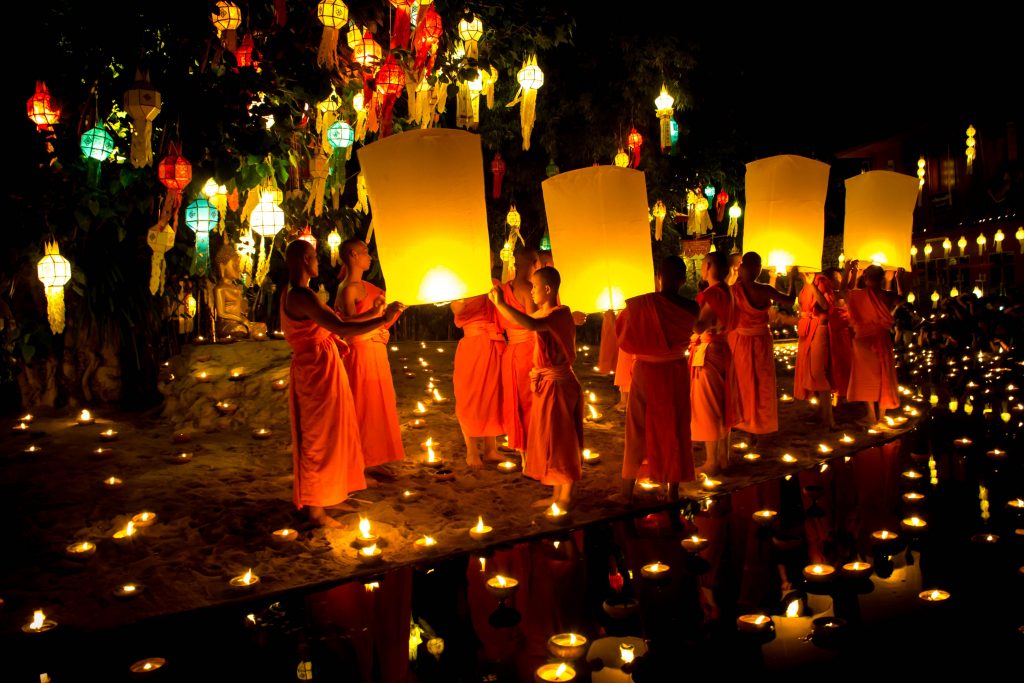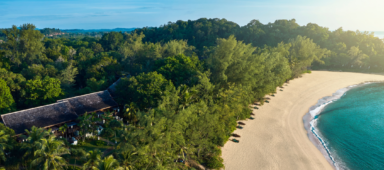The Thai capital is an assault on the senses, but beneath the chaotic traffic and market bustle is a city steeped in sacred traditions.
Words Kieran Smith

MODERN MALLS AND MAKESHIFT MARKETS
Each floor of the towering Terminal 21 mall represents a different location — from Rome, Paris, Istanbul and London to the Caribbean. Aside from the usual international chain stores, there are plenty of independent market stalls selling unique products. The real treat, however, is the food court on the fifth floor, where you can find delicious (and cheap) local cuisine. The coconut ice cream is highly recommended!
When it comes to meeting locals and haggling for local produce, the Ratchada Train Market is the place to be. Wander down endless rows of tightly packed stalls selling all manner of souvenirs, snacks and vintage goods — from Vespa scooters to beetles on a stick — and then quench your thirst with a fresh coconut.


PEACEFUL PARKS AND GREEN RETREATS
As night falls, strolling lovers, athletes and people-watchers head to Benjasiri Park. Here, you can rent a swan and pedal out to the still water reflecting the city lights, or just take a breather by strolling amid the palms as the heat of the day fades away.
Nestled on a curl in the Chao Phraya river is Bang Kachao — a tree-filled island known as Bangkok’s green lung. Take a long-tail taxi boat across the water, pick up a rental bike, and spend the day rolling by temples, parks and the island’s very own floating market.
TRANQUIL URBAN TEMPLES

Sitting on the west bank of the Chao Phraya River is one of Bangkok’s oldest and most revered temples, Wat Arun, or the Temple of Dawn. This is a must-visit for Buddhist culture enthusiasts and is best seen — as the name suggests — at sunrise.

A few short hours by bus or train from Bangkok lie the spectacular ruins of Thailand’s former capital, Ayutthaya, now a modern yet majestic Thai city studded with headless Buddhas and the towers of crumbling temples.
MINGLING WITH THE SACRED AND THE PROFANE
Thai culture is built on sacred foundations; these come to the surface every April at the Songkran festival, where for three days, water is thrown over all and sundry to symbolise the washing away of misfortune from the previous year.
The narrow, bustling alleys of Chinatown — or Yaowarat —are lively every day of the year, but at Chinese New Year, this excitement is catalysed with theatrical dragon parades, lion dances, firecrackers and more iconic red Chinese lanterns than ever.

One of the most picturesque festivals in Bangkok is the evening of Loy Krathong, which usually falls in early November at the end of the rainy season on a full moon. Here, people gather around lakes, rivers and canals to pay respect to the Goddess of Water by releasing lotus-shaped rafts — lit up with candles and awash with the colours of flowers — into the water to drift away.
EAT YOUR WAY THROUGH THAI CULTURE
A stone’s throw from Wat Pho is Thip Samai, a restaurant famous for Thailand’s signature dish, pad thai noodles, available with seafood or as a vegetarian dish, washed down with freshly squeezed orange juice. Expect to queue for 45 minutes at least.
Long ago, locals would quickly slurp miniature bowls of noodles after unloading cargo from long-tail boats on the canal. Today, this style of eating is popular with students and tourists as it allows the sampling of several different flavours in one sitting. The most famous is Boat Noodle Alley, just north of the Victory Monument.

Best visited at night, this densely packed warren of streets in Chinatown hosts all manner of stalls, offering some of the more daring and adventurous street cuisine that Asia has to offer. Just follow the fragrances that waft off every corner, and you will find your way to gastronomic contentment.
The king of fruits, durian, has a unique spiky appearance, and an even more memorable smell. This much-celebrated fruit is a Bangkok favourite, and you would be wise to not leave the city without sampling it first, even if you do have to hold your nose!
GET ACTIVE – THAI STYLE
Muay Thai tourism has grown in recent years, but even if you don’t want to get in the ring, this ancient martial art is also a popular spectator sport, and there are two big stadiums to catch a thrilling Muay Thai fight: Ratchadamnoen Stadium, the oldest in Bangkok, and Lumpini Stadium.
Cycling might seem perilous in the chaos of Bangkok traffic, but colourful city backstreets offer peaceful exploration by bike —you can rent or sign up for a bicycle tour to guide you around the riverside temples and artefacts of the old city.
The closest beach is several hours from Bangkok, but Flow House is an artificial wave machine and beach club in the heart of Bangkok that brings the waves and the chilled vibes to the city. This is a great way for the whole family to have fun, keep fit and cool off while enjoying some surfing and bodyboarding.
VISIT AT LEAST ONE ART MUSEUM
Take two hours out of your exploration to meander down the corridors of the Museum Of Contemporary Arts, and absorb a variety of Thai art styles, from the traditional to the contemporary.
USEFUL TIPS
- Order coffee mai wan — Thailand has a very sweet tooth. If you like your iced coffee not piped full of sugar, then just utter this phrase, meaning literally ‘no sweet’.
- Order food mai ped — Food vendors lather their food in hot chilli sauce, and if you cannot speak Thai, then you have little hope of stopping them! If don’t want your tongue burnt off, try this phrase, or ped nid noi, if you like a little spice.
- Carry cash — Cash remains king in Thailand, and cards are not widely accepted. Even at ATMs, foreign cards are hit with a hefty withdrawal fee.
- Go by meter — Taxis or tuktuks but make sure you agree on the price in advance, or use the meter.






